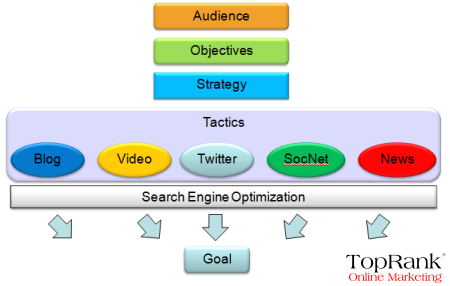Despite company marketing budgets on hold or in a state of ambiguity, businesses are scrambling over social media, trying to figure out how to boost sales and keep the customers they have. SEO is an online marketing tactic that’s been tried and true for well over 10 years and is still earning its stripes in the marketing mix.
On their own, SEO and social media efforts offer companies attractive opportunities for reaching new customers, which is how many marketers implement them.
When you look at shifts in consumer information discovery, consumption and sharing, there’s no arguing with the intersection of search and the social web. Searchers expect to not only find what they’re looking for on search engines, but to interact with the results, whether it’s through commenting, voting or sharing. As a result, social media affects SEO in numerous ways, creating opportunities for marketers.
For a step by step guide on creating a S0cial Media SEO Roadmap, take a look at this recent article from Mashable. Below is a partial exceprt:
From a marketing standpoint, you can look at the benefits of SEO and social media two different ways:
First, implementing a social media marketing program without optimizing content is leaving money on the table. Useful social content (blog, video, images, audio) that cannot be discovered via search is a lost opportunity to reach an audience that is looking.
For example, the popular blog about student loans and college financing from Wells Fargo identifies 29 keywords in its Keyword Meta Tag and doesn’t rank in Google’s first page for 26 of them. Those that do rank are variations of the blog’s name.
While there is a generous amount of cross linking within posts, a basic blog template optimization effort leveraging keywords and other minor adjustments could improve search traffic for this site substantially – without any compromise in content quality or user experience.
Social interactions and media sharing amongst social network participants create the kind of content that can improve a brand’s visibility within search results through profiles, videos, blog posts, or other media. A good example is Stormhoek wines’ first page Google rankings including blogs, Facebook and Twitter.
On the flip side, implementing SEO programs without leveraging the content distribution and linking benefits of social web participation makes link building for SEO an uphill battle. The nature of the social web encourages participation: sharing, voting, commenting & linking. Popular social content gets exposure, traffic and can result in a substantial number of relevant inbound links.
As an example, the famous Blendtec iPhone video which as received so much attention on social media sites, has attracted over 6,000 links resulting in a top ten ranking on Google for the word, “blender”.
Bottom line? Content + Links = Search Engine Success!
Throwing keywords at social media tactics isn’t quite the same thing as developing and implementing a plan to reach specific goals. Link drop social media tactics can have impact but are difficult to sustain. For long term value from effort, marketers should follow social media best practices as wel as the fundamentals:
- Identify the specific audience they’re trying to reach – behaviors, preferences for content, sharing, media types, etc
- Set specific goals and objectives that can be measured
- Work out a strategy for reaching those goals with the intended audience
- Figure out which mix of tactics will support and execute the game plan
- Put proper measurement tools in place and identify what events and outcomes to analyze
For a step by step guide to creating a SEO & Social Media Marketing Roadmap, check out the full article on Mashable, “Social Media and SEO: 5 Essential Steps to Success“.



